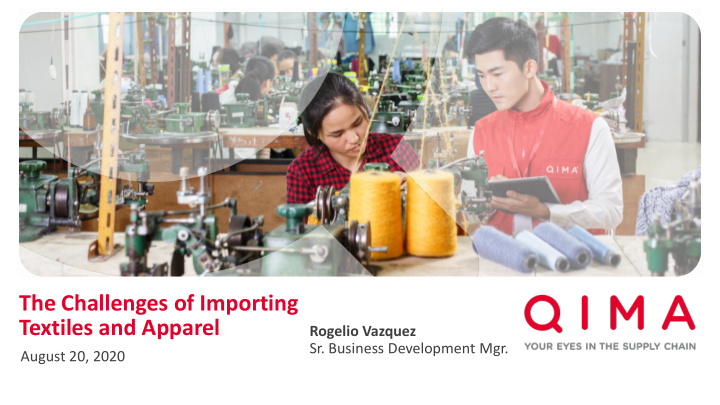



The Challenges of Importing Textiles and Apparel Rogelio Vazquez Sr. Business Development Mgr. August 20, 2020
What are the Challenges of the Textile Industry Supply Chain? 2 info@qima.com 2 info@qima.com
Textile Industry Challenges Quality Issues Incorrect Uncut thread sewing 9% 6% 20% of inspections beyond AQL Stains/Dirt (measurement) Pukering Marks Most 1% 2% common defects found 18% Incorrect Holes of inspections labels 0.9% beyond AQL 0.7% (workmanship) Source: QIMA data 3 info@qima.com
Textile Industry Challenges Quality Issues 20% Why? of inspections beyond AQL Limited supply chain (measurement) visibility Poor factory quality control Lack of management 18% knowledge and training of inspections Reliance on manual beyond AQL processes (human error) (workmanship) Source: QIMA data 4 info@qima.com
Textile Industry Challenges The risk of mold and bug infestations can lead to total product loss 5 5 info@qima.com info@qima.com
Textile Industry Challenges Mold Impact on the product Factors Bad smell Average monthly temperature over 82ºF Poor look Relative humidity higher Weaken the material and than 65% stitching Metal stains 6 6 info@qima.com info@qima.com
Textile Industry Challenges Mold Did you know? 90% of the world’s It’s also the region with the apparel is produced in highest annual rainfall globally, South and Southeast with an average 2000-3000mm Asia (78-118 inches) 7 7 info@qima.com info@qima.com
Textile Industry Challenges Bug Infestation Factors Hygienic factory conditions Temperature and humidity Product packaging and storage Shipping conditions 8 info@qima.com
Diversification Challenges Risks Drivers Insufficient providers Low quality US tariffs towards China Lesser production capacity High production demand COVID-19 Lack of product expertise Increase in delivery times 9 info@qima.com
What can I do? Where should I start? 10 10 info@qima.com info@qima.com
Quality Assurance vs Quality Control Quality control Quality Assurance Focus on the product Focus on production Reactive measure process Defect identification Proactive measure Defects prevention 11 11 info@qima.com info@qima.com
Quality Control Textile composition Initial Production Check Chemistry tests During Production Inspection Performance tests Pre-Shipment Inspection Container Loading Check Production Monitoring 12 12 info@qima.com info@qima.com 12 12
Quality Control Purchase Order + = 13 info@qima.com
Quality Control Monthly Production Supplier A Supplier B Supplier C Purchase Order Purchase Order Purchase Order 14 info@qima.com
Quality Control Yearly Production Independent Decisions Isolated information Lack of historical data Poor visibility on defect trends Limited supplier performance tracking High quality control cost 15 15 info@qima.com info@qima.com
Importance of Technology in the Supply Chain Defects Information Factory Mapping Identify unauthorized subcontracting Spot common defects Identify trends Geographic visibility of the supply chain Filter data by factory, brand or product Supplier performance ranking Optimize and better allocate your quality control budget 16 info@qima.com
Quality Assurance | Audit Factory Audits Factory Improvement Programs Manufacturing Audit Initial evaluation Ethical or Social Audit Corrective Action Plan (CAP) Environmental Audit Follow up audits Structural Audit Continuous Improvement Plan Technical Audit C-TPAT 17 17 info@qima.com info@qima.com
Quality Assurance | Upstream Control 20% of defects found in garments Visibility and Control: are related to Fabric Trace raw material performance from origin to final manufacturing issues and could product be avoided Identify the “weak points” in your supply chain Defects Prevention: Get it Right-First Time , reducing waste, rework and costs Identify and correct mistakes on initial stages of the production Drive Continuous Improvements: Optimize the factory quality management systems Use data to increase process efficiency 18 info@qima.com
Quality Assurance | Continuous Improvement CONTINUOUS IMPROVEMENT Intervention Impact REVIEW AND Reduce defects ADJUST IDENTIFY Root Causes More efficient processes IMPLEMENT Corrective Actions Improved Data Collection & Action Plan traceability TRAIN Factory Staff Supplier cooperation CONTINUOUS IMPROVEMENT 19 19 info@qima.com info@qima.com 19 19
Success Case Study – Quality Assurance Initial Audits Factories Assessment 4.7 /10 13 13 Audits Average Score Production Improvement Program Factory A (2 audits) Factory B (3 audits) 6.2 /10 8.4 /10 4.5 /10 6.0 /10 8.1 /10 Jan ‘19 May ‘19 Mar ‘18 Jan ‘19 May ‘19 20 20 info@qima.com info@qima.com
Success Case Study – Quality Assurance Defects classification procedures Implementation of best practices Factory staff training 21 info@qima.com
In Conclusion… Informed Supply Chain Decisions Visibility Accurate Data in Real-Time Increase in Better Quality Business Administration Efficiency 22 info@qima.com
QIMA can Help! + Quality Control Quality Assurance 23 info@qima.com
Our Team of 2,500+ Qualified Inspectors, Auditors and Lab Engineers Perform Services in 85 Countries In 2020, we will deliver more than 400,000 inspection, audit, testing and certification reports for brands, retailers and importers globally. 24 info@qima.com
QIMA Supply Chain Insights Page Find our latest quarterly barometer See the results of our yearly global sourcing survey Download white papers and quick guides which offer insights not quality control issues globally based on our research and analysis Visit: https://www.qima.com/supply- chain-insights 25 info@qima.com
Remote Guided Inspections Leveraging QIMA’s extensive inspection experience, with a team of specialist supervisors who are experienced in managing inspectors Utilizing livestreaming technology , a QIMA supervisor remotely guides factory staff through the inspection and collects evidence of the product’s quality Booking, checklist and overall process is the same as with a QIMA Onsite Inspection . A detailed inspection report is provided within the same day and real-time analytics are available in your QIMA dashboard 26 info@qima.com
PPE Inspections Apparel capacities converted to PPE on large scale (China, Vietnam, Bangladesh, Cambodia, Myanmar, etc.) PPE for domestic use and import QIMA has inspected over 1.2 billion face masks to date 27 info@qima.com
Q&A 28 info@qima.com
Email: info@qima.com Visit: www.qima.com
Recommend
More recommend